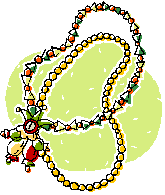



|
Beads: Let Me Tell You Their Life Story By Kerris Samson It is thought that the earliest recorded use of beads was by the Egyptians and there are certainly lots of items from the Egyptian period, but bead work has also been found dating back as far as the Stone Age. Many beads were added to their clothing and were made from shells and ivory and although they were not as finely crafted as beads of a later date, they were still in fact beads. So you can say that even at the time of the caveman and woman they were interested in making improvements to their clothing and appearance with beads. The beads which are traditionally used in beadwork are called seed beads because they are small and resemble a seed. These types of beads were used by the Egyptians in their beadwork and were called Faience beads. The faience bead was often made from quartz particles fused together compared to the beads of today which are made from glass. A glaze would then be applied over the quartz and they would then be woven or strung together either as jewelry or adornments on clothing. During the excavation of King Tut’s tomb beaded necklaces were found along with other beaded items which included a pair of slippers he wore as a childe and a hassock. It is most unusual for this sort of beadwork to survive as they were often strung on cords made from leather or cloth which often disintegrate as time goes by, yet it is fortunate that we have a few examples which give us an idea on the history of Egyptian beading. In some religious texts from India there is reference to beads having been woven into hair and horse’s tails from around the 9th Century BC. Also there is evidence that beads were being widely used throughout Asia in ancient times and some beaded items have been found in temples in Japan that date as far back as 800 AD. Most early beads were produced using shells, ivory and stone and the early Egyptians valued the beads according to the kind of stone that was used, in fact it was thought that different stones had different properties. For example, Lapis Lazuli (a gorgeous blue stone) was thought to protect the wearer’s health and would often be fashioned into beads along with Carnelian, Feldspar, Amethyst, Turquoise and Jasper, and which are still used today. In about 1480 glass was introduced to produce beads when the Venetians began drawing glass tubes and turning them into beads. Certainly once the technology for pulling glass tubes had been invented and perfected it became easy to produce thousands of beads which were not just uniform in size but also in colour and shape. Certainly you will find that modern jewelry and beading benefits from the advances which were made in the production of beads in the early centuries and even today a bead which has been individually handcrafted can become the star attraction in any beading item.
About the
Author:
|
|
|---|
Search the Web: 
Custom Search
|
Contact Us |
|---|